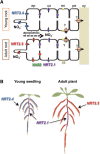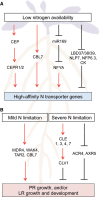Plant Nitrogen Acquisition Under Low Availability: Regulation of Uptake and Root Architecture
- PMID: 27025887
- PMCID: PMC4836452
- DOI: 10.1093/pcp/pcw052
Plant Nitrogen Acquisition Under Low Availability: Regulation of Uptake and Root Architecture
Abstract
Nitrogen availability is a major factor determining plant growth and productivity. Plants acquire nitrogen nutrients from the soil through their roots mostly in the form of ammonium and nitrate. Since these nutrients are scarce in natural soils, plants have evolved adaptive responses to cope with the environment. One of the most important responses is the regulation of nitrogen acquisition efficiency. This review provides an update on the molecular determinants of two major drivers of the nitrogen acquisition efficiency: (i) uptake activity (e.g. high-affinity nitrogen transporters) and (ii) root architecture (e.g. low-nitrogen-availability-specific regulators of primary and lateral root growth). Major emphasis is laid on the regulation of these determinants by nitrogen supply at the transcriptional and post-transcriptional levels, which enables plants to optimize nitrogen acquisition efficiency under low nitrogen availability.
Keywords: Acquisition efficiency; Limitation; Nitrogen nutrient; Root architecture; Uptake.
© The Author 2016. Published by Oxford University Press on behalf of Japanese Society of Plant Physiologists.
Figures


References
-
- Araya T., Kubo T., von Wiren N., Takahashi H. (2015) Statistical modeling of nitrogen-dependent modulation of root system architecture in Arabidopsis thaliana. J. Integr. Plant Biol. 58: 254–265. - PubMed
-
- Bouguyon E., Brun F., Meynard D., Kubeš M., Pervent M., Leran S., et al. (2015) Multiple mechanisms of nitrate sensing by Arabidopsis nitrate transceptor NRT1.1. Nat. Plant 1: 15015. - PubMed
Publication types
MeSH terms
Substances
LinkOut - more resources
Full Text Sources
Other Literature Sources

